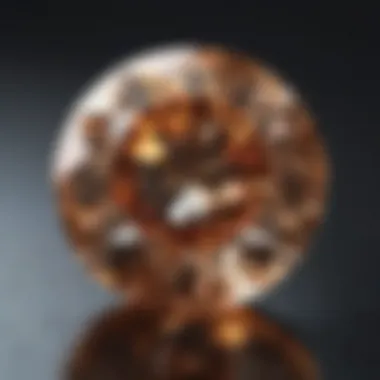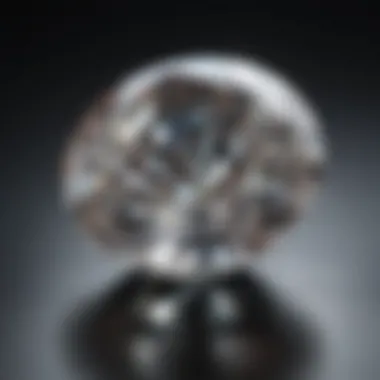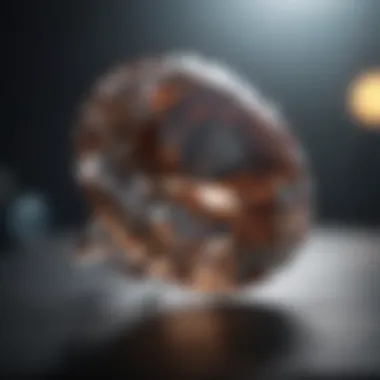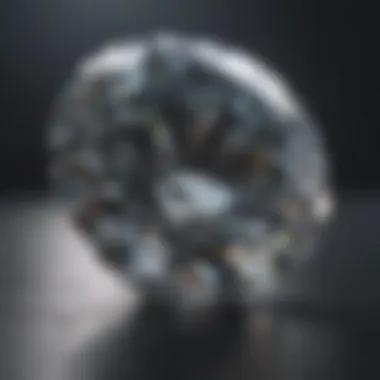A Comprehensive Guide to Checking Diamond Quality


Intro
Understanding diamond quality is pivotal for both buyers and sellers in the gemstone market. When assessing a diamond, there are crucial factors that determine its overall value and desirability. This guide aims to unveil the complexities behind diamond evaluation, focusing significantly on the four Cs—carat, cut, color, and clarity. Additionally, it covers advanced evaluation methodologies, the importance of certification, and the influence of market trends. By dissecting these elements, we empower our readers to make informed decisions, whether they are seasoned jewelers or individuals looking to purchase a cherished piece.
Gemstone Overview
Definition and Characteristics
Diamonds are a form of carbon that crystallize under intense heat and pressure deep within the Earth's mantle. They are revered for their exceptional hardness and brilliance, making them a preferred choice in jewelry. A key characteristic of diamonds is their ability to refract light. This results in the distinctive sparkle that captivates many.
Diamonds come in various forms, with natural diamonds mined from the earth and synthetic diamonds created in laboratories. While both exhibit similar physical properties, the processes of creation differ significantly and can influence value.
Classification of Gemstones
Beyond diamonds, gemstones can be classified into two primary categories: precious and semi-precious. Precious gemstones include diamonds, sapphires, emeralds, and rubies, recognized for their rarity and significant value. Semi-precious stones, while still valued, are more common and include varieties like amethyst and garnet.
In the context of diamonds, the classification often focuses on factors such as size, color, and clarity. Each unique stone has distinct properties that can affect market value and demand.
Historical Significance
Ancient Uses and Cultural Importance
Historically, diamonds have held a prominent role across various cultures. In ancient India, diamonds were considered symbols of strength and invincibility. They were often used in weaponry and armor, believed to enhance the warrior's abilities.
As civilizations evolved, the perception of diamonds shifted from mere tools to coveted adornments. They came to symbolize wealth, power, and love—often encapsulated in the tradition of engagement rings in modern society.
Myths and Legends Surrounding Gemstones
The allure of diamonds has generated numerous myths and legends throughout history. One prevalent belief is that diamonds imbue the wearer with invincible powers and health benefits. Some cultures also associate certain gemstones with celestial powers, believing they can influence fate and fortune.
The combination of ancient uses and the romantic symbolism associated with diamonds makes them a fascinating subject for both history enthusiasts and gemstone collectors.
"The value of diamonds has always transcended their physical properties, captivating generations with their beauty and the stories behind them."
Understanding Diamond Quality
In the landscape of gemstones, diamonds occupy a unique position. Their allure stems not only from beauty but from the depth of meaning and value attributed to them. Understanding diamond quality is crucial for anyone involved in the purchasing or evaluating process. The quality of a diamond can significantly affect its market price and desirability.
The four Cs—carat, cut, color, and clarity—serve as the foundational pillars for assessing diamond quality. Comprehending these criteria enables buyers to make informed decisions, ensuring that they acquire the most suitable gem for their needs. By grasping the nuances of each attribute, one can appreciate how they interact and contribute to the overall appeal of a diamond.
Defining Diamond Quality
Diamond quality encapsulates various factors that influence a diamond's appearance and value. It is not a singular measure but a combination of attributes that collectively define the overall integrity of the stone. For instance, carat weight refers to the size and weight of the diamond, which can affect its market value significantly. However, size alone does not dictate desirability. Other elements like cut quality, which impacts how light interacts with the diamond, also matter.
Moreover, color refers to the presence of hues that may detract from a diamond's overall appeal. A clear, colorless diamond tends to be more valuable than one with noticeable coloration, generally graded on a scale. Clarity, assessing intrinsic flaws known as inclusions and blemishes, completes this triad. Identifying the presence and visibility of these features plays a vital role in determining value.
Ultimately, diamond quality combines personal preference and intrinsic attributes, guiding consumers toward choices aligned with their values and needs.
The Importance of Quality Assessment
Assessing diamond quality holds significant importance for buyers and sellers alike. For consumers, understanding quality enables more satisfying purchases, minimizing the risk of overpaying for stones that lack aesthetic appeal or integrity. Knowledge in this area fosters confidence, enhancing the purchasing experience.
For jewelers, assessment skills translate into credibility and trust in the marketplace. Customers expect expertise and informed recommendations, making quality awareness an essential component of professional practice. Accurate assessments can help differentiate genuine gemstones from imitation products or lower-quality diamonds.


"Education on diamond quality equips consumers with essential tools for confident decision-making."
Additionally, the diamond market is fluid, affected by trends and consumer preferences. Thus, keeping abreast of quality assessment practices can lead to better investment decisions. The ability to evaluate diamonds accurately places individuals in a stronger position, whether they are buying for personal enjoyment, gifting, or investing.
The Four Cs of Diamonds
The Four Cs form the cornerstone of understanding diamond quality. This framework encompasses carat, cut, color, and clarity, each playing a significant role in determining the value and aesthetic appeal of a diamond. For anyone considering a diamond purchase, be it for personal use or as an investment, familiarity with these criteria is essential. Each component of the Four Cs contributes uniquely; neglecting any one of them can lead to misguided choices or overvaluation.
Carat Weight Explained
Carat weight is a measure of the diamond's size. One carat equals 200 milligrams. While it may seem straightforward, buyers often misunderstand its significance. Larger diamonds are rarer and often more valuable; however, weight alone does not dictate a diamond's overall quality. A well-cut one-carat diamond can appear larger than a poorly cut diamond of the same weight. Therefore, jewelers encourage a balanced consideration of carat weight alongside the other Cs.
- Weight Perception: A diamond's appearance can vary based on its cut and proportions, so two diamonds of the same carat weight may have different perceived sizes.
- Rarity: Diamonds over two carats significantly increase in price due to their scarcity in nature.
Evaluating Cut Quality
The cut of a diamond refers to how well it has been shaped and faceted. It dramatically affects the stone's brilliance and sparkle. The ideal cut maximizes the diamond's light reflection, resulting in a captivating display. Unlike the other Cs, cut is the one attribute that jewelers can manipulate during production. Therefore, understanding cut quality is crucial for buyers.
A well-cut diamond will:
- Reflect light beautifully, creating a bright and lively appearance.
- Show fire, which refers to the color spectrum of light that a diamond emits.
- Exhibit scintillation, the flashes of light produced as the diamond moves.
Understanding Diamond Color Grading
Color grading measures the absence of color in a diamond, with D being completely colorless and Z indicating light yellow. Generally, a colorless diamond holds a higher value. However, the perception of color can be subtle; buyers often prefer near-colorless diamonds for their beauty and value.
- The GIA Grading Scale: This scale ranges from D (colorless) to Z (light yellow). Most diamonds intended for jewelry fall between G and J.
- Considerations for Investment: For those considering diamond investment, D-F color grades are usually the preferred options, while G-J can provide better value.
Clarity: Assessing Inclusions and Blemishes
Clarity refers to the presence of inclusions or blemishes within or on the surface of a diamond. These imperfections can affect both the beauty and the value of a diamond. Every diamond has some level of inclusions, often invisible to the naked eye.
- GIA Clarity Scale: The scale ranges from Flawless (no inclusions visible under 10x magnification) to Included (inclusions visible without magnification).
- Impact on Value: Diamonds that rank higher on the clarity scale are typically more desirable and valuable.
In assessing diamonds, clarity is often secondary to cut in terms of overall visual impact. A well-cut diamond may appear more brilliant than a flawless one that lacks proper faceting.
Understanding the Four Cs provides a fundamental framework for anyone engaging in the diamond market. Each attribute feeds into the larger narrative of a diamond’s quality, allowing buyers to make informed decisions.
Measuring Diamond Quality: Tools and Techniques
Assessing diamond quality extends beyond just visual inspections. It's crucial to employ specific tools and techniques that offer high accuracy and confidence in determining a diamond's worth. This section delves into the myriad methods jewelers and buyers use, highlighting the advantages and considerations for each approach. By understanding how to properly measure diamond quality, one can significantly improve their purchasing decisions and ensure they are acquiring a gem that meets their expectations.
Using a Loupe for Clarity Assessment
A loupe, also known as a jeweler's loupe, is a small magnifying glass designed to aid in the scrutiny of diamonds. This tool is vital for assessing clarity, as it enables users to examine inclusions and blemishes in great detail. A clarity grade can substantially affect a diamond's value, thus understanding how to use a loupe is essential.
When utilizing a loupe, look for tiny imperfections that may be present within the gem. These can range from internal flaws to surface scratches. Typically, when examining with a loupe, clarity grades can be assigned, which play a key role in the valuation process. The ability to spot these details enhances one's knowledge about the diamond's quality.
Light Performance Measurement
To grasp the beauty of a diamond, light performance is crucial. This involves analyzing how well a diamond interacts with light, contributing to its overall visual appeal. Three primary attributes play into this measurement: brilliance, fire, and scintillation.
Brilliance


Brilliance refers to the amount of white light that reflects from the surface of the diamond and within its interior. This quality enhances the stone's brightness. A diamond with high brilliance appears lively and eye-catching, captivating any viewer. For buyers, a diamond demonstrating superior brilliance is often preferred, as it indicates high-quality cut and light return.
Fire
Fire is the term for how a diamond disperses light into the colors of the spectrum, producing flashes of color as the stone moves. A diamond with great fire appears vibrant and dynamic. This characteristic adds a layer of beauty that many find desirable. Hence, diamonds that exhibit this feature are often considered more appealing, garnering a higher market value.
Scintillation
Scintillation encompasses the sparkle that a diamond emits when moved. This quality is the result of light reflecting off the facets at various angles. Diamonds that exhibit exceptional scintillation are highly sought after for their ability to catch and reflect light. When evaluating a diamond, its scintillation contributes significantly to the perceived quality.
The Role of Measurement Tools
To accurately assess diamonds, several tools are essential. Not only do they assist in determining the quality, but they also enhance the overall appraisal process.
Microscope
A microscope is an advanced tool used to inspect diamonds beyond the capabilities of a loupe. It provides a more in-depth view of inclusions and craftsmanship. By utilizing a microscope, gemologists can identify the specific characteristics of the stone with precision. This attribute makes the microscope a superior choice for clarity evaluation, especially for high-value diamonds. However, the intricate working process may require training to utilize effectively.
Protractor
The protractor is a tool often overlooked in gemology, yet it plays a vital role in measuring angles on the diamond's facets. Angles significantly influence a diamond's light performance and overall appearance. A well-cut diamond will have precise measurements that maximize its brilliance and scintillation. Therefore, using a protractor can help in assessing whether a diamond is well-cut or poorly cut, affecting both its appearance and its market worth.
Using the right tools is crucial in accurately assessing diamond quality. Understanding how to implement these techniques enhances both the purchasing experience and the value of the investment.
Certification and Grading Standards
Understanding the importance of certification and grading standards is crucial for anyone engaged in the diamond market. Talking about diamonds is not just about beauty and elegance; it requires a solid foundation of knowledge and standards to make informed decisions. Certification helps to authenticate a diamond’s quality and ensures that its most essential characteristics are accurately communicated. These certificates provide a third-party verification from professional gemological institutes. This guarantees both the buyer's confidence and the integrity of the gem.
Understanding Gemological Institutes
Gemological institutes play a vital role in the diamond industry. These organizations specialize in evaluating diamonds, providing grading reports that detail various quality factors, including the Four Cs: carat weight, cut, color, and clarity. Prominent institutes include the Gemological Institute of America (GIA), the International Gemological Institute (IGI), and the American Gem Society (AGS). Each of these organizations has its own set of standards and methodologies for grading diamonds, but generally, they follow similar guidelines that ensure consistency in the assessment process.
When buying a diamond, it's advisable to seek those certified by reputable gemological institutes. This certification adds a layer of assurance for customers. Without proper certification, it can be challenging to assess whether the diamond matches the seller's claims.
Reading a Diamond Grading Report
A diamond grading report is an essential document that provides detailed information about a diamond's characteristics. Knowing how to read this report can empower buyers in their purchasing decisions. Key elements to look for include the following:
- Carat Weight: This indicates the size of the diamond. Larger carats typically command higher prices but consider it alongside other factors.
- Cut: This defines how well a diamond reflects light. The better the cut, the more brilliance the diamond will exhibit.
- Color: This denotes the presence of color in a diamond. The grading scale generally ranges from D (colorless) to Z (light yellow).
- Clarity: This refers to the presence of imperfections, known as inclusions or blemishes. Higher clarity grades suggest a more valuable diamond.
Additionally, examine the report for any specific comments from the gemologist regarding the diamond’s characteristics. These insights can provide further context to the graded attributes. A grading report is not just a number; it is a comprehensive overview that informs consumers about the essential details, making it easier to compare different diamonds.
Proper certification and understanding of grading standards can save buyers from potential pitfalls and enhance their confidence in their purchases.
In summary, certification and grading standards are central to the diamond buying experience. They inform buyers about the authenticity and quality of a diamond, guiding them towards making educated choices. Both the gemological institutions and grading reports are integral elements in achieving this clarity.
Practical Tips for Assessing Diamonds
Assessing diamonds requires a balance between knowledge and intuition. This section will focus on practical tips that enhance both in-person evaluations and online purchasing strategies. Understanding these aspects is crucial for making informed choices in the complex diamond market. Knowledge of diamonds goes beyond the basic characteristics; the execution of practical tips can enhance the overall experience of diamond assessment.
In-Person Qualitative Assessment
When assessing diamonds in person, familiarity with the environment and the diamond itself can greatly influence your experience. Here are some key elements to keep in mind:


- Lighting Conditions: Natural daylight can reveal a diamond’s true qualities. In a store, overhead lighting can distort colors. Consider stepping outside or finding a well-lit area to evaluate the diamond appropriately.
- Use of Tools: A jeweler's loupe is an essential tool for detailed inspection. Familiarize yourself with how to use this device. This tool magnifies the diamond, helping to spot inclusions and evaluate clarity effectively.
- Physical Feel: Hold the diamond to gauge its weight and how it feels in your hand. A diamond should possess a certain heft, reflecting its carat weight.
- Visual Inspection: Look for the overall appearance, such as fire and scintillation. Turn the diamond under light to see how it reacts. Pay attention to the reflections, as they can indicate cut quality.
Online Purchase Considerations
Purchasing diamonds online presents a unique set of challenges and advantages. Awareness of specific factors is essential for a satisfactory acquisition:
- Trustworthy Sources: Always buy from reputable retailers with solid customer reviews. Reputable websites usually provide detailed descriptions and high-resolution images that help assess quality.
- Certification: Ensure the diamond has a grading report from a recognized institution like the Gemological Institute of America (GIA). These reports provide vital information regarding the diamond’s quality metrics permissible.
- Return Policy: A good return policy is crucial. Make sure to understand the terms, in case the diamond does not meet your expectations upon receiving it.
- Video Consultation: Some retailers offer video consultations, allowing you to view the diamond in real-time. Take advantage of this feature if available; asking questions as you see the diamond can give you insights not possible through static images.
Understanding Market Trends
Understanding market trends is vital when assessing diamond quality. The diamond market is not a static environment; it evolves continuously based on various factors including demand, economic conditions, and consumer preferences. By grasping these trends, both buyers and sellers can make strategic decisions that optimize their investments and purchases.
One crucial element to consider in the diamond market is how consumer behavior shifts influence pricing. Economic growth often leads to an increase in disposable income, encouraging purchases of luxury items such as diamonds. Conversely, during times of recession, demand may decrease, which can lower prices. Being aware of these fluctuations helps collectors and investors time their purchases more effectively, ensuring they acquire diamonds at the right moment.
Moreover, trends can also reflect broader shifts in the jewelry industry. For example, the increasing popularity of lab-grown diamonds has significantly impacted the natural diamond market. Understanding how these and similar trends play out is key to navigating the complexities of diamond quality assessment.
The specificity of diamond types, including shapes and settings, may also alter based on trends in fashion and celebrity influence. Jewelers must stay attuned to these shifts to not only satisfy customer desires but also participate actively in the evolving market landscape.
Another important consideration is sustainable practices in diamond sourcing. Consumers today are increasingly aware of ethical issues surrounding conflict diamonds and environmental concerns. This growing consciousness can affect which diamonds are favored and how they are marketed, making it essential for sellers to stay informed about societal attitudes.
"Awareness of market trends can significantly enhance one’s decision-making capabilities regarding diamond purchases and investments."
Value Determinants in the Diamond Market
Several factors determine the value of diamonds in the market. One primary determinant is the quality assessment based on the Four Cs: carat, cut, color, and clarity. Each of these characteristics contributes significantly to a diamond's overall value. The carat weight, for example, directly correlates to the stone’s size and should be balanced with cut and clarity for maximum appeal.
Additionally, market conditions, such as the supply and demand dynamics of certain diamond categories, greatly influence value. For instance, round brilliant diamonds often hold higher resale value because of their popularity and consistent demand. In contrast, some fancy shapes might have lower demand despite being unique.
Another determinant is the source of the diamond. Originating from well-known and reputable mines can boost a diamond’s value. Similarly, diamonds with certifications from esteemed gemological laboratories such as GIA or AGS are often valued higher.
Investment Potential of Diamonds
Investing in diamonds can be a strategic choice, particularly for those looking to diversify their portfolios. The investment potential is largely influenced by the rarity and quality of the stones. High-quality, rare diamonds tend to appreciate over time, especially if they possess unique characteristics or provenance.
Moreover, unlike stocks or bonds, diamonds are tangible assets, offering a sense of security to their owners. They are also less susceptible to market volatility, which can be advantageous during economic downturns. Such qualities elevate diamonds as a preferred choice for long-term investment.
Another aspect worth considering is how changes in global markets can affect diamond prices. Economic indicators, geopolitical stability, and shifts in consumer preferences can create opportunities for savvy investors.
Closure: Making Informed Choices
The process of purchasing a diamond is not simply about selecting a shiny piece of jewelry. It demands a nuanced understanding of various factors that influence the quality and value of a diamond. This conclusion section draws attention to the importance of making informed choices, by synthesizing the information covered throughout this guide. Having a comprehensive knowledge of the four Cs—carat, cut, color, clarity—equips buyers with the essential tools to discern the worth of different diamonds available in the market.
A buyer's understanding of the certification process is equally critical. Certificates from reputable gemological institutes, such as GIA or AGS, serve as guides that provide detailed information about a diamond's quality. Recognizing how to read these grading reports ensures that one appreciates the parameters that define value, thus avoiding pitfalls in the purchasing journey.
Moreover, considering market trends and investment potential reveals the broader implications of acquiring a diamond. Prices can fluctuate due to various factors like rarity and demand, making it wise to stay informed about these dynamics. This awareness not only assists in making financially sound decisions but also enhances the overall satisfaction derived from the purchase.
By synthesizing the key aspects of diamond quality assessment and staying educated throughout the buying process, consumers can navigate the intricacies of the diamond market.
"Informed decisions lead to valuable investments. Understanding diamond quality is essential for prosperity in the market."
Recap of Key Considerations
- The Four Cs: Understanding carat weight, cut quality, color grading, and clarity is paramount for accurate evaluation. Each C contributes uniquely to a diamond’s overall appearance and value.
- Certification Importance: Certificates are vital for establishing authenticity and trust in a diamond's grading. Look for diamonds graded by well-known gemological institutes.
- Market Knowledge: Staying updated on market trends can help anticipate price changes and investment opportunities. Fluctuations based on demand can vastly affect value.
- Practical Assessment Techniques: Various tools and methods, such as loupes and professional grading systems, are essential in conducting informed evaluations.
- Online Purchase Caution: In the digital age, understanding how to assess diamond quality when buying online is crucial. Rely on trusted websites and seek certified products.
The Impact of Education on the Purchase Journey
Education acts as a pivotal tool in the journey of purchasing a diamond. A well-informed buyer stands a much better chance of making smart investments. Armed with knowledge, purchasers can spot quality discrepancies that might otherwise go unnoticed. For example, understanding the differences in cut grades can reveal how light performance influences a diamond’s brilliance.
Additionally, a solid grounding in the diamond market allows buyers to navigate options more confidently. Knowledge about trends, such as shifts in consumer preference or evolving technology in diamond grading, empowers buyers to anticipate changes and make decisions accordingly.
Through educational resources and practical experience, individuals can refine their ability to assess diamonds accurately. This empowers not only collectors and enthusiasts but also those who are investing significantly in something with deep personal value.







